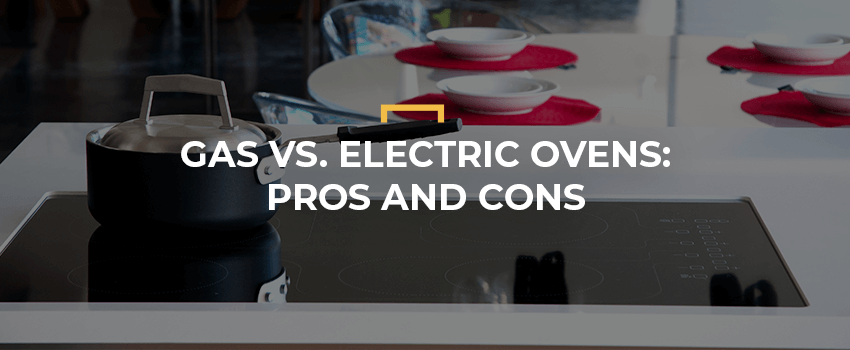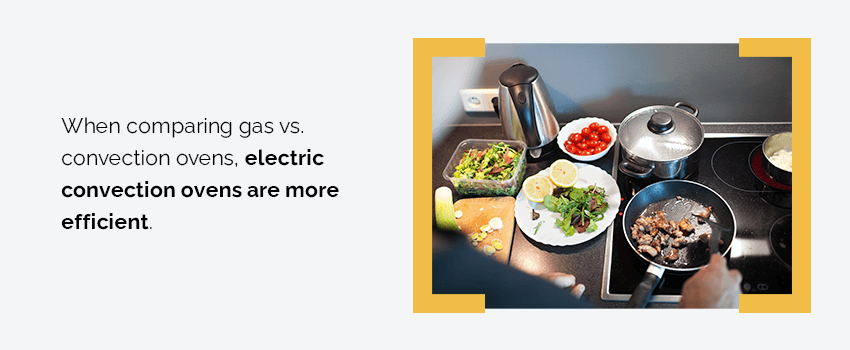
Gas vs. Electric Ovens: Pros and Cons
- Home
- Gas vs. Electric Ovens: Pros and Cons

When starting a kitchen remodel, picking a new oven is essential. Updated ovens offer more efficient, safer cooking and a more comprehensive range of styles. The stove you choose is heavily influenced by your home’s existing power source and your budget. Finding the best oven that will work with your kitchen cabinets will give you a lasting appliance and ensures your cooking process is more streamlined.
Let’s compare gas vs. electric ovens and see their pros and cons.
The most significant difference between these two types of ovens is how they work. Their different fuel sources affect their designs, cooking and efficiency. Understanding how gas and electric ovens work is the first step in determining which oven is right for you.
Gas ovens use propane or natural gas as the fuel source. Gas stoves heat food from burners inside the oven. Gas ranges are a stovetop and oven combination, with the stovetop featuring multiple open flame burners.
Electric ovens run on electricity. Though older model cooktops feature electric coils, modern versions use induction and smooth top cooktops. Electric ovens have interior elements that heat the food through radiation and convection. Electric ovens come in oven and stovetop combinations, but you can also get separate electric wall ovens and cooktops.
Now that you understand the basics of how gas and electric ovens work, let’s look at their pros and cons. These factors will help you decide which range you’d like to get and how they might align with your cooking and kitchen cabinet layout.
The exact cost of your oven will depend on the model you get. The more added features it has and the newer it is, the more expensive your range will be. Additionally, if you’re converting from electric to gas or gas to electric, the cost of converting will increase your spending.
Electric ranges will typically cost less to install than gas ranges. The other cost you should consider is fuel — you’ll use your oven frequently, and the fuel for your oven will affect long-term costs. For most places in the United States, natural gas is cheaper than electricity. It’ll be less expensive to install an electric oven but more costly to run it long-term.
Gas ovens require professional installation — working with gas can be extremely dangerous, especially if you have little experience working with gas stoves. Gas stove installation is more expensive because of this.
Electric stove hookup and installation are much simpler than gas. As long as your home is already set up for an electric oven, the appliance simply needs plugging in. Additionally, a mounting plate might be necessary to keep the stove in place.
Cleaning a smooth top or ceramic electric cooktop is more straightforward than cleaning a gas oven. These ovens just need simple wipe-downs to remove dirt from the surface. Traditional electric coil stoves, however, are about as easy to clean as gas stoves.
Both electric coil and gas stoves need their individual grate or coil elements wiped down and removed to thoroughly deep clean the surface. Both have heating elements that should stay dry and free of cleaning solution, as they can become unsafe if heated with chemicals present.

Gas ovens have lower operational costs than electric ovens, but the heating efficiency of the range often depends on the model combined with the oven type. Gas cooktops are more efficient than electric when cooking on the stove — you have better control over the gas levels for heating, and gas offers a more even, consistent cook.
When comparing gas vs. convection ovens, electric convection ovens are more efficient. Convection ovens use fans and exhaust systems to blow hot air onto the food in the oven, providing an even, more efficient cook. Additionally, gas is overall more energy efficient than non-convection electric ranges.
Electric heating warms up and cools down more slowly than gas flames. This means electric ovens take longer to cook food than gas. However, newer electric stove models are comparable to gas ovens for heating up food. Technological advances have allowed new electric ranges to mimic the heating capabilities of natural gas flames.
Gas allows better control over temperatures than electricity. Since you directly control the flame size and, therefore, the heat levels of a gas stove, you get more control over your cooking temperatures. Electric ranges use dials to control the temperature, but that’s not quite as precise as directly influencing the flame cooking your food.
Electric ovens are safer than gas ovens. Since gas ovens use actual gas for power and heat, there are safety risks associated with them. Improper installation and wear and tear can cause gas stoves to leak. Also, gas stoves release small amounts of toxic nitrogen dioxide, so they need good ventilation. Finally, anytime you’re cooking or working with an open flame, there’s always an increased risk of danger.
Electric stoves can still cause fires, but they’re overall safer than their gas counterparts. Modern technology makes electric appliances incredibly safe to use, so there are fewer risks associated with electric stoves compared to gas.
Before choosing an oven, it also helps to consider how gas vs. electric ovens pair with different cabinet design styles. This way, you can choose an oven that complements your style and blends seamlessly with your kitchen cabinet design.
Gas stoves usually feature metal grates, allowing pots to rest directly over an open flame. For this reason, gas stoves pair well with classic cabinet styles with their glossy wood finishes and more exposed wood grain. That old-fashioned appeal works well with the traditional gas stove and provides a rustic charm to any kitchen space.
At the same time, if you’re a fan of the modern kitchen design look, electric stoves often pair well with modern-style cabinets. That’s because newer electric oven models often sport a flat ceramic or glass surface atop heating coils, offering a minimalist look that pairs well with the uniform, modern cabinet style.
Dual-fuel ranges combine both gas and electric oven features for an improved kitchen range. Dual-fuel ranges have gas stovetops and electric ovens, providing maximum temperature control on the stove and in the oven. Gas stovetops offer the best surface cooking control, while the heat cycling patterns of new electric ovens improve oven cooking. Dual-fuel ranges offer the benefits of both oven types in one convenient range.
The main downside to a dual-fuel range is cost. Since this oven combines gas and electric features, it typically comes with a higher price tag than solely gas or electric ranges. Additionally, you’ll have to pay for a gas line installation if your home doesn’t already have one.
While both gas and electric stoves have their pros and cons, the most essential factor is your oven model. The higher the quality of your model, the better it’ll perform, regardless of its power source. Upgrading your kitchen appliances allows you to enjoy more efficient, advanced cooking.
At Bath, Kitchen & Tile, we carry top-of-the-line kitchen ovens and appliances to fit your unique kitchen cabinet remodel. Our high-quality products ensure you’ll enjoy attractive, durable kitchen appliances for years to come. Our award-winning design team will work with your tastes to help you design a kitchen remodel that will elevate the look and efficiency of your home.
Get started on your remodel and contact our team today.